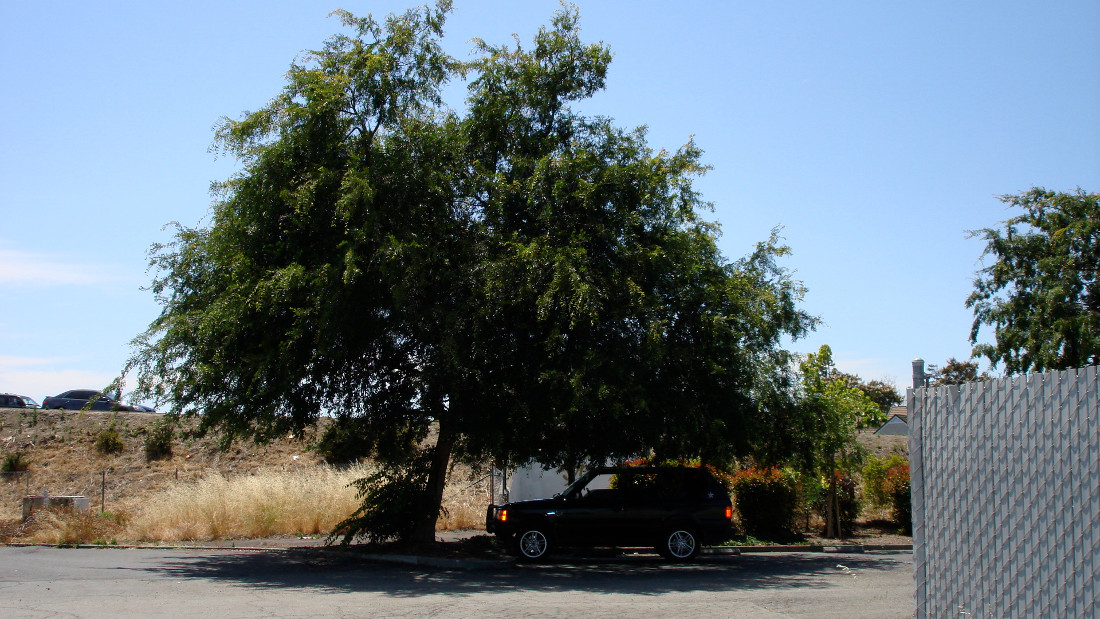When an urban site is developed, existing mature trees are often removed to facilitate construction. After the building is up, “replacement” trees are often planted, depending on local ordinances. Will these trees actually make up for what is lost? Certainly not at first. Studies show that trees can take 26 to 40 years to become net carbon reducers. Is it possible to predict the benefits of those replacement trees once those initial decades have passed?
Urban Tree Canopy (UTC) is defined as the layer of leaves, branches, and stems that cover the ground when viewed from above. For a single tree, UTC could be calculated by measuring canopy “length” and “width” from below and calculating canopy square footage. Measuring UTC can be a good way to calculate the amount of stormwater interception or shade provided by tree canopies. However, this method may not give us a true account of other ecosystem services such as carbon sequestration, or any other benefits provided by a full canopy.
UTC doesn’t take into account any malpruning the tree may have had. If the tree has been overthinned, for example, there won’t be a normal amount of leaves in the middle of the tree, and the canopy square footage will be overstated. The UTC method also doesn’t consider the third dimension: canopy height. A tree may have its normal canopy spread but the main leader and upright branches topped for views, or been excessively crown-raised (too many lower branches removed from below). In either case, the canopy height will be less than it should be for a tree allowed to develop “normally,” resulting in reduced leaf volume.
A more complete way to model tree growth was published this year by the U.S. Forest Service. The technical manual and database projects growth for 171 different tree species across 16 U.S. climate zones. Collecting this data took over 14 years and analyzed over 14,000 individual trees. Using this model, if you know the species and age of the tree, you can predict the following:
- trunk diameter at breast height (DBH)
- tree height
- crown height
- leaf area
- foliar biomass
Getting the above information takes time: The User Guide, which starts on page 67 of the technical manual, details the six different steps needed to use the various tables and look up the information. If you were hoping for an “oracle” that gave you the requested information quickly, you will be disappointed (although at least you don’t have to do the math calculations yourself). If you are modeling tree growth for a variety of species, you will have to look up the information repeatedly following the steps in the User Guide. (Dear readers: If a simple user interface has been created for using the database, please share it with us in the comments.)
The model, for all its comprehensiveness, does have some limitations:
- It’s based on a small sample size and not too many tree species.
- There was difficulty in obtaining accurate age data. (For this research, age refers to years after planting rather than years after germination.) Planting records older than 30-40 years are rarely available.
- Management practices vary wildly. Topping, overthinning and excessive crown-raising will cause trees to have less crown height, leaf area, and foliar biomass than projected. These trees will therefore provide fewer ecosystem services than they should.
Back to the hypothetical development project removing the hypothetical mature trees and replanting. Using the U.S. Forest Service model, it is possible to calculate the size (and therefore benefits) of proposed replacement trees and, if existing trees are still there, to compare them to the benefits already being provided with the following caveats:
- Any proposed benefits will take 20 to 40 years to be realized.
- The replacement tree must be free of uncorrectable root defects to attain its potential size and lifespan.
- There must be adequate soil volume for the tree to reach its full height. Research by Dr. Nina Bassuk of Cornell University indicates that a tree needs two cubic feet of soil for every square foot of crown projection. In other words, to attain a crown spread of 30 feet in diameter, the tree should have 1,000 cubic feet of uncompacted soil, equivalent to a planting area 10 feet wide, 34 feet long and 3 feet deep.
- The tree must survive its initial establishment period of 3 to 5 years, during which it is extremely vulnerable to drought stress and vandalism. A study monitoring 5 years of tree planting in Oakland, California indicated that annual tree plantings barely outpaced young tree deaths – truly a “running to stand still” situation.
- Assuming the tree is defect-free, growing in adequate soil volume, and survives to maturity, it must then be allowed to develop to its potential mature size and foliage density. After initial structural training, the tree must be pruned no more than needed to attain clearances for vehicles, pedestrians, buildings etc. As per professional pruning standards, trees should not lose more than 25% of the living foliage in one year. No topping, overthinning or excessive crown raising must be done.
Given the gauntlet that an urban tree must run to provide the needed ecosystem services, the odds are stacked against a young tree ever “replacing” a mature one. This begs the question: wouldn’t our time and energy be better spent preserving the mature trees we already have?
YES.
Ellyn Shea is a consulting arborist in San Francisco.
Top image courtesy of Hoerr Schaudt. All other images courtesy of Ellyn Shea.









Wow this is some really extensive data. We run a tree removal company in Atlanta and we see a lot of these same issues there for the urban areas that are replanting. It’s crazy to think how many years it will take to replace what is lost in terms of carbon reduction.